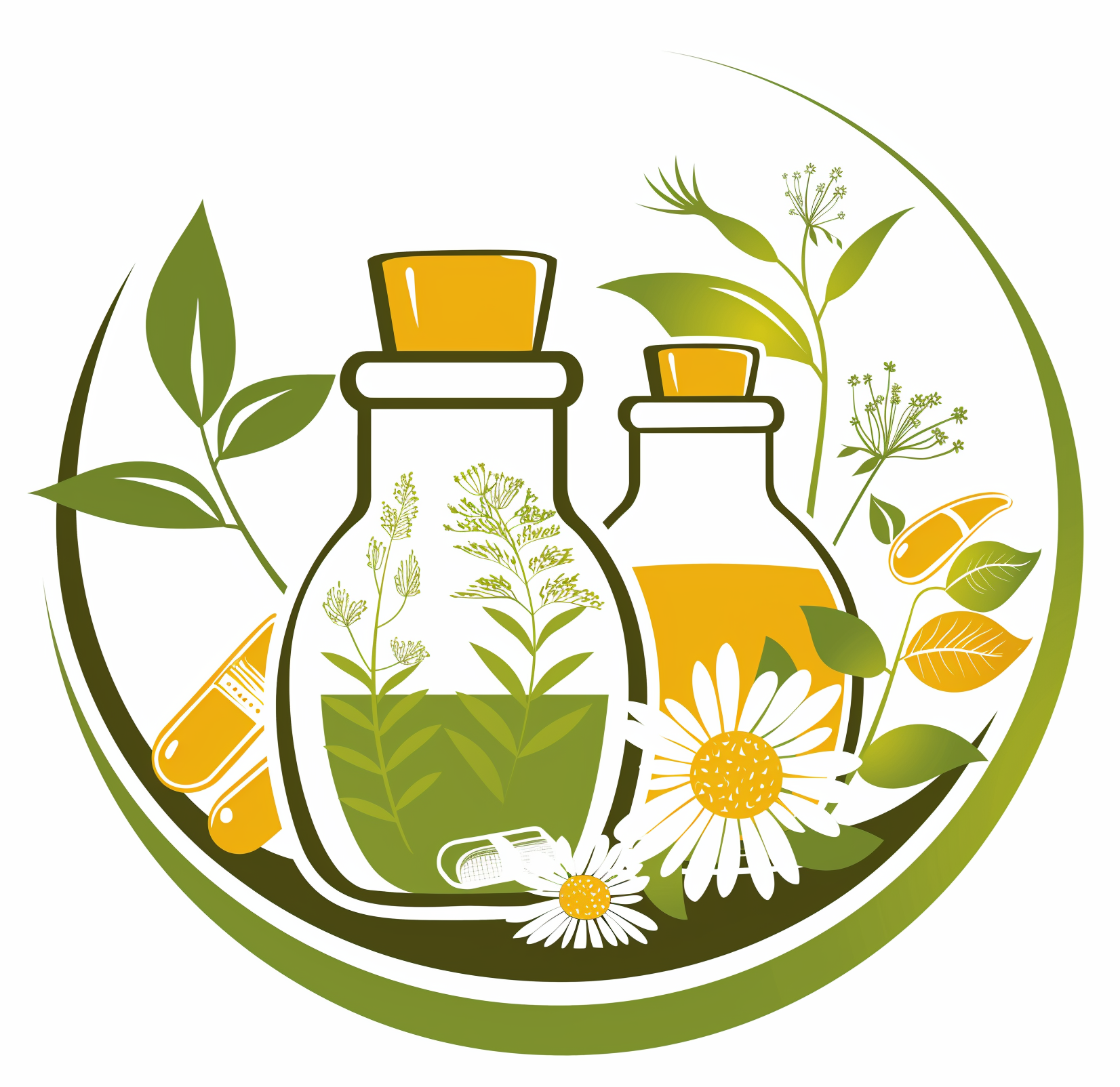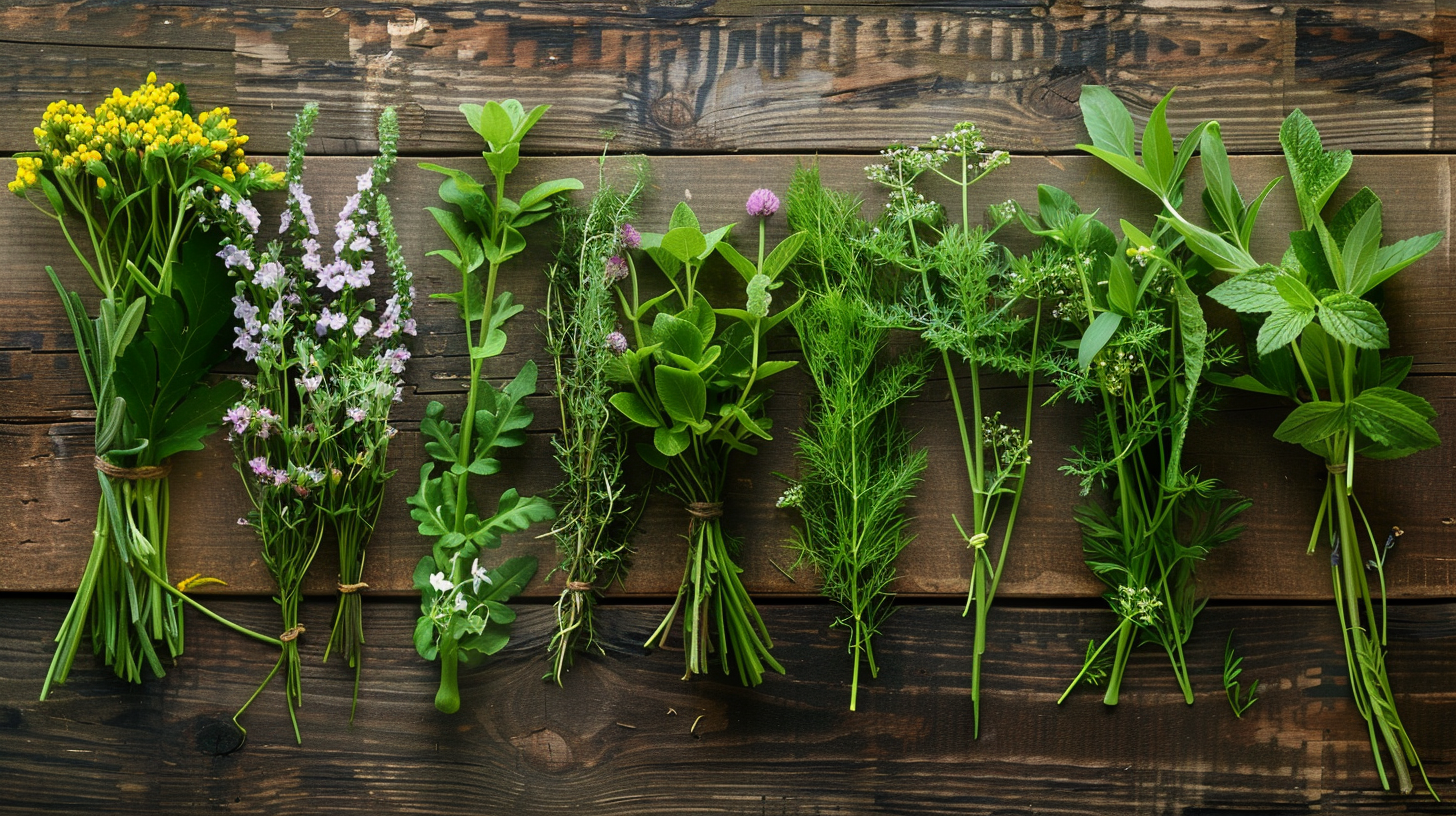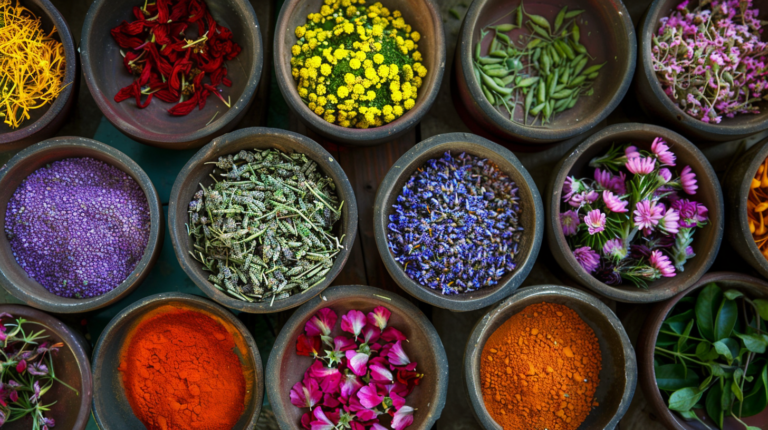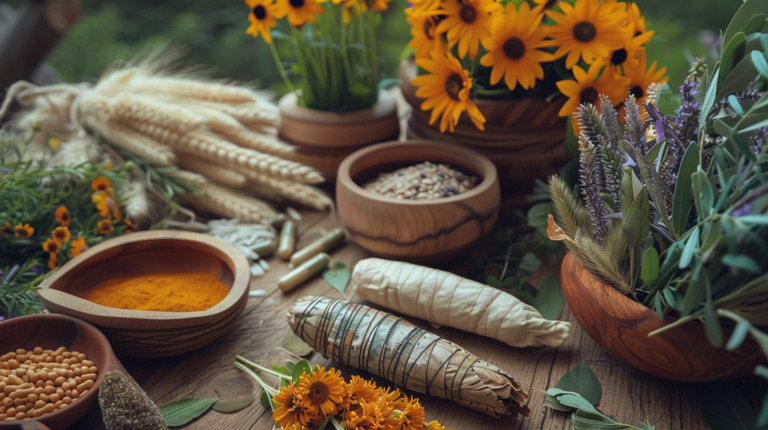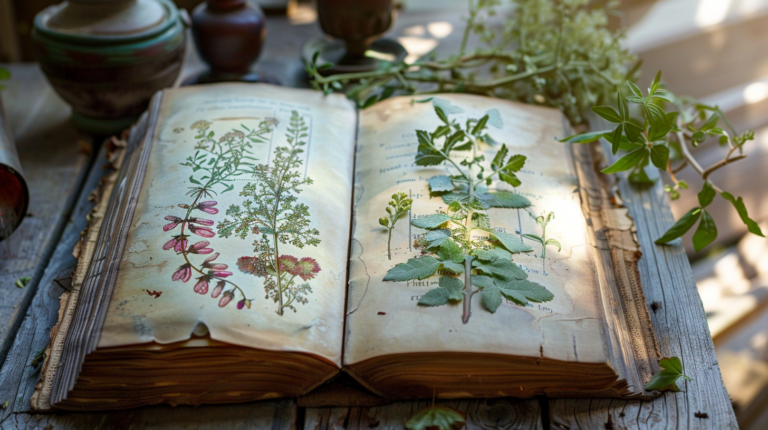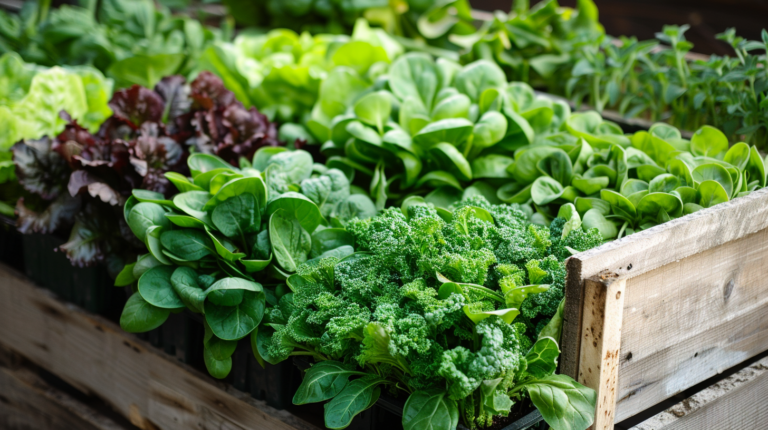Guide to Common Wild Herbs: Identification, Uses, and Benefits
Imagine stepping into the wild, uncharted woods, your senses overwhelmed by the aroma of fresh leaves and flowers. Yet, despite this natural bounty, many people today struggle to recognize and utilize these amazing gifts from nature.
A primary issue is the sheer discomfort with the unknown. The potential risks and the complexity involved in plant identification keep many from even attempting to explore what’s right under their noses.
What if I told you that with the right knowledge, navigating through the world of common wild herbs could not only be safe but deeply rewarding? Learning about edible wild plants and their edible parts can open up a new realm of flavors and health benefits that nature has reserved for us. From foraging delicious wild foods like the stinging nettle (Urtica dioica) to nurturing your body with wild edibles, the journey to rediscovering these plants is easier and more joyful than you might think.
Understanding Common Wild Herbs
Introduction to Wild Herbs
Definition and Overview
Wild herbs are a fascinating aspect of nature, often growing in abundance just outside our doorsteps. These resilient plants are not only beautiful to behold but also packed with a myriad of nutritional and medicinal benefits. Imagine being able to step outside and pluck your own remedies right from your yard! The term “wild herb” generally refers to any edible or medicinal plant that grows spontaneously in the wild, free from human intervention. They have evolved to thrive in their native environments, offering a bounty of benefits to those who know where to look.
Historical Uses and Significance
Throughout history, wild herbs have played a crucial role in healing practices across cultures. Ancient healers like Hippocrates and traditional Chinese medicine practitioners relied heavily on wild herbs to treat a plethora of ailments. Take the humble dandelion, for example. Did you know that it has been used for centuries to treat everything from liver issues to skin problems? Or consider stinging nettle, once utilized by Roman soldiers to alleviate sore muscles by whipping themselves with its leaves—a practice known as urtication. The historical significance of wild herbs is a testament to their enduring utility and resilience.
Finding and Identifying Wild Herbs
Ideal Locations to Search
When it comes to foraging for wild herbs, location is key. These plants thrive in various habitats, each offering unique species to discover. For those in North America and Europe, common wild herbs can be found in meadows, woodlands, and even urban areas such as parks and abandoned lots. Personally, I love to start my foraging adventures in the early spring, when young leaves are tender and edible. Coastal areas and riverbanks are also hotspots for a diverse range of wild plants.
Key Identification Tips
Identifying wild herbs can be both an art and a science. Key features to look for include the leaves, flowers, and overall growth habits of the plant. Squat down to examine the leaf arrangement: Are they opposite or alternate? Do they have a unique odor or taste? Additionally, flowering season can provide vital clues. For instance, yarrow, with its distinct feathery leaves and flat-topped clusters of small, white flowers, is easy to identify once you get the hang of it.
Safety and Ethical Considerations
While the excitement of finding your own wild foods can be exhilarating, it’s essential to practice safety and ethics. Never consume any parts of a wild plant unless you are absolutely certain of its identification. Always cross-reference with multiple sources and consider consulting a local expert. Ethical foraging involves taking only what you need, leaving plenty for wildlife and the plant to continue flourishing. Remember, some species may be protected or endangered. Happy foraging, but tread lightly and responsibly!
Common Wild Herbs and Their Uses
Dandelion (Taraxacum officinale)
The dandelion is one of the most easily recognized wild herbs. Every part of this plant is edible and beneficial, from its roots to its bright yellow flowers. Young leaves can be eaten raw in salads or cooked in soups. Dandelions are not just a nuisance in your lawn; they are a nutritional powerhouse packed with vitamins A, C, and K. The roots can be made into a tea that supports digestion and liver health. It’s a great starting point for those new to foraging.
Nettle (Urtica dioica)
Stinging nettle may not sound like a friendly plant, but don’t let its prickly exterior fool you. When cooked, nettles lose their sting and become a rich source of iron, calcium, and protein. The young leaves are best harvested in spring and can be added to soups, stews, or even made into pesto. Due to their anti-inflammatory properties, nettles have been used traditionally to treat arthritis and other inflammatory conditions. They grow abundantly in Europe and North America, making them an accessible and valuable wild food.
Plantain (Plantago major)
Often considered a pesky weed, plantain is anything but! This common wild herb has broad, oval leaves and a unique ability to draw toxins out of the body. The leaves can be turned into a poultice for insect bites, stings, and minor wounds. Rich in vitamins A and C, plantain can also be used in salads or smoothies. When you’re out foraging, look for it in disturbed soils, lawns, and along pathways. Its versatility and medicinal properties make it a must-have in any wild herb guide.
Yarrow (Achillea millefolium)
Yarrow is a beautiful plant famed for its medicinal uses. Its fern-like leaves and clusters of small white flowers are unmistakable. Historically, it’s been used to stop bleeding and treat wounds—hence its nickname, ‘Soldier’s Herb.’ Yarrow tea can help with fevers, colds, and digestive issues. It grows in a variety of habitats, including fields and on the edges of forests. Make sure to gather the flowers when they are in full bloom for maximum potency.
Clover (Trifolium pratense)
Both red and white clover are valuable wild edible plants. Red clover, in particular, is rich in isoflavones, which are beneficial for menopausal health. Its flowers can be dried and used in teas or eaten fresh in salads. Clover leaves are edible raw or cooked and provide a mild, slightly sweet flavor. Be sure to look for these wild plants in open fields and grassy areas. They not only enrich the soil with nitrogen but also support the body’s detoxification processes.
Understanding Common Wild Herbs
Introduction to Wild Herbs
Definition and Overview
Wild herbs are a fascinating aspect of nature, often growing in abundance just outside our doorsteps. These resilient plants are not only beautiful to behold but also packed with a myriad of nutritional and medicinal benefits. Imagine being able to step outside and pluck your own remedies right from your yard! The term “wild herb” generally refers to any edible or medicinal plant that grows spontaneously in the wild, free from human intervention. They have evolved to thrive in their native environments, offering a bounty of benefits to those who know where to look.
Historical Uses and Significance
Throughout history, wild herbs have played a crucial role in healing practices across cultures. Ancient healers like Hippocrates and traditional Chinese medicine practitioners relied heavily on wild herbs to treat a plethora of ailments. Take the humble dandelion, for example. Did you know that it has been used for centuries to treat everything from liver issues to skin problems? Or consider stinging nettle, once utilized by Roman soldiers to alleviate sore muscles by whipping themselves with its leaves—a practice known as urtication. The historical significance of wild herbs is a testament to their enduring utility and resilience.
Finding and Identifying Wild Herbs
Ideal Locations to Search
When it comes to foraging for wild herbs, location is key. These plants thrive in various habitats, each offering unique species to discover. For those in North America and Europe, common wild herbs can be found in meadows, woodlands, and even urban areas such as parks and abandoned lots. Personally, I love to start my foraging adventures in the early spring, when young leaves are tender and edible. Coastal areas and riverbanks are also hotspots for diverse ranges of wild plants.
Key Identification Tips
Identifying wild herbs can be both an art and a science. Key features to look for include the leaves, flowers, and overall growth habits of the plant. Squat down to examine the leaf arrangement: Are they opposite or alternate? Do they have a unique odor or taste? Additionally, flowering season can provide vital clues. For instance, yarrow, with its distinct feathery leaves and flat-topped clusters of small, white flowers, is easy to identify once you get the hang of it.
Safety and Ethical Considerations
While the excitement of finding your own wild foods can be exhilarating, it’s essential to practice safety and ethics. Never consume any parts of a wild plant unless you are absolutely certain of its identification. Always cross-reference with multiple sources and consider consulting a local expert. Ethical foraging involves taking only what you need, leaving plenty for wildlife and the plant to continue flourishing. Remember, some species may be protected or endangered. Happy foraging, but tread lightly and responsibly!
Common Wild Herbs and Their Uses
Dandelion (Taraxacum officinale)
The dandelion is one of the most easily recognized wild herbs. Every part of this plant is edible and beneficial, from its roots to its bright yellow flowers. Young leaves can be eaten raw in salads or cooked in soups. Dandelions are not just a nuisance in your lawn; they are a nutritional powerhouse packed with vitamins A, C, and K. The roots can be made into a tea that supports digestion and liver health. It’s a great starting point for those new to foraging.
Nettle (Urtica dioica)
Stinging nettle may not sound like a friendly plant, but don’t let its prickly exterior fool you. When cooked, nettles lose their sting and become a rich source of iron, calcium, and protein. The young leaves are best harvested in spring and can be added to soups, stews, or even made into pesto. Due to their anti-inflammatory properties, nettles have been used traditionally to treat arthritis and other inflammatory conditions. They grow abundantly in Europe and North America, making them an accessible and valuable wild food.
Plantain (Plantago major)
Often considered a pesky weed, plantain is anything but! This common wild herb has broad, oval leaves and a unique ability to draw toxins out of the body. The leaves can be turned into a poultice for insect bites, stings, and minor wounds. Rich in vitamins A and C, plantain can also be used in salads or smoothies. When you’re out foraging, look for it in disturbed soils, lawns, and along pathways. Its versatility and medicinal properties make it a must-have in any wild herb guide.
Yarrow (Achillea millefolium)
Yarrow is a beautiful plant famed for its medicinal uses. Its fern-like leaves and clusters of small white flowers are unmistakable. Historically, it’s been used to stop bleeding and treat wounds—hence its nickname, ‘Soldier’s Herb.’ Yarrow tea can help with fevers, colds, and digestive issues. It grows in a variety of habitats, including fields and on the edges of forests. Make sure to gather the flowers when they are in full bloom for maximum potency.
Clover (Trifolium pratense)
Both red and white clover are valuable wild edible plants. Red clover, in particular, is rich in isoflavones, which are beneficial for menopausal health. Its flowers can be dried and used in teas or eaten fresh in salads. Clover leaves are edible raw or cooked and provide a mild, slightly sweet flavor. Be sure to look for these wild plants in open fields and grassy areas. They not only enrich the soil with nitrogen but also support the body’s detoxification processes.
Benefits of Wild Herbs
Nutritional Benefits
Wild herbs are an excellent source of nutrients and can often be superior to cultivated greens. For instance, eddle is packed with iron, calcium, and vitamins A, C, and K, making it a nutritional powerhouse. Regular consumption of wild herbs can enhance your diet and provide essential nutrients that contribute to overall health. Moreover, they are free from pesticides and chemicals often found in commercial produce, making them a safer alternative.
Medicinal Properties
Many wild herbs have potent medicinal properties, offering natural remedies for common ailments. Plantain can soothe insect bites and minor wounds, while yarrow is renowned for its ability to stop bleeding and support digestive health. These plants have been used for centuries in traditional medicine and are still effective today. Incorporating wild herbs into your wellness routine can reduce the reliance on pharmaceutical medications and provide gentle healing.
Environmental Impact
Foraging for wild herbs has a positive environmental impact. By using naturally occurring plants, we reduce the demand for mass-produced crops that can deplete soil nutrients and rely heavily on chemical fertilizers and pesticides. Additionally, foraging promotes biodiversity and helps maintain healthy ecosystems. When done responsibly, it ensures the sustainability of wild plant species and their habitats. It’s a way to connect with nature while contributing to environmental conservation.
Harvesting and Storage Techniques
How to Harvest Wild Herbs
Harvesting wild herbs requires a bit of knowledge and care. First, ensure that you have positively identified the plant and that it is safe to consume. Use clean, sharp scissors or a knife to cut the leaves, flowers, or other parts of the plant. Harvest in the morning after the dew has dried but before the sun is too high, as this is when the plant’s oils are most potent. Always take no more than a third of the plant to ensure it can continue to grow and reproduce.
Drying and Preserving Methods
To preserve wild herbs for later use, drying is the most common method. Spread the leaves and flowers in a single layer on a mesh screen or hang them in small bunches in a well-ventilated, dark area. Once dried, store them in airtight containers away from direct sunlight. You can also preserve herbs by making tinctures, oils, or vinegar infusions, which capture the plant’s medicinal properties and extend their shelf life.
Storing for Long-term Use
Proper storage is key to maintaining the efficacy of your wild herbs. Store dried herbs in glass jars with tight-fitting lids, away from light and moisture. Avoid using plastic containers, as they can degrade over time and affect the quality of the herbs. Label your jars with the name of the herb and the date it was harvested. When stored correctly, dried herbs can last up to a year, while tinctures and oils can be potent for several years.
Recipes and Practical Applications
Infusions and Teas
Herbal infusions and teas are simple ways to enjoy the benefits of wild herbs. To make an infusion, pour boiling water over fresh or dried herbs, cover, and steep for 10-20 minutes. Yarrow tea, for example, can help with fever and digestive issues, while nettle tea provides a nutrient boost. You can also blend different herbs to create unique flavors and enhance their health benefits. Experiment with combinations like dandelion and mint for a refreshing and detoxifying drink.
Salves and Balms
Making salves and balms from wild herbs is a rewarding way to utilize their healing properties. Infuse oils with herbs like plantain or comfrey, then mix with beeswax to create soothing balms for skin irritations, cuts, and bruises. Yarrow and calendula salve, for instance, is excellent for treating wounds and promoting skin health. These homemade remedies are gentle, free from synthetic ingredients, and can be customized to suit your needs.
Cooking with Wild Herbs
Wild herbs can add unique flavors and nutritional value to your meals. Use young dandelion leaves in salads, add nettles to soups and stews, or blend clover flowers into pesto. Cooking with wild herbs not only diversifies your diet but also reintegrates ancient culinary practices into modern life. Forage in your backyard or local woods, and bring the bounty of nature to your table. Your taste buds—and your health—will thank you!
Conclusion
Empowering with Nature’s Bounty
Embracing wild herbs allows us to reconnect with nature and harness its healing power. These resilient plants, growing abundantly around us, offer solutions to many of our nutritional and medicinal needs. By learning to identify, harvest, and use wild herbs responsibly, we can enrich our lives and support our health naturally. The knowledge and practice of foraging and using wild herbs are empowering, reminding us of the bountiful gifts nature provides.
Taking the Next Steps
Ready to dive deeper into the world of wild herbs? Start by exploring your local environment, joining foraging groups, and educating yourself with books and courses on herbalism. Practice by creating simple teas, tinctures, and balms, and experiment with cooking wild edibles. As you grow more confident, you’ll discover an endless array of possibilities and benefits. The journey with wild herbs is not just about plants; it’s about forging a deeper connection with the natural world. Happy foraging!
